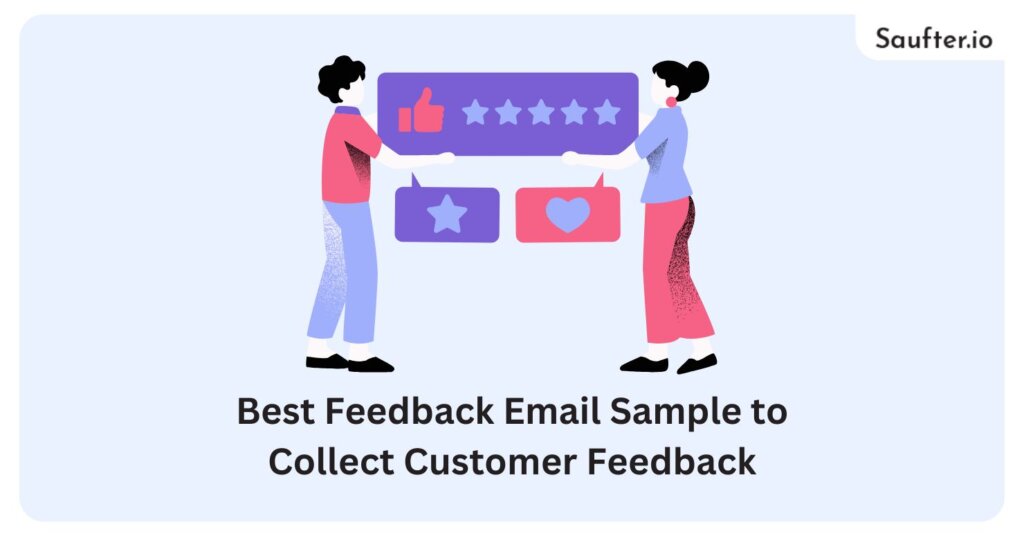Last Updated: September 2025
Collecting customer feedback is crucial for any business aiming to improve its offerings and enhance the customer experience. In fact, a report by Microsoft reveals that 90% of consumers consider customer service a key factor in their brand loyalty.
One of the most effective ways to gather insights is by using a well-written feedback email sample. Whether you’re a startup or a growing enterprise, having the right email template can significantly boost response rates.
In this article, we’ll share 8 of the best feedback email sample templates to help you engage your customers and collect meaningful feedback effortlessly.
Why Use Feedback Emails?
Feedback emails are one of the most effective ways to find out what your clients really think. They not only help you see what’s working and what isn’t, but also let your customers know their opinions are valued. This small move can do wonders for gaining your customers’ trust and keep them coming back for more.
By sending a targeted feedback email sample, you can:
- Identify Pain Points: Learn where your product, service, or support may be falling short.
- Enhance Customer Experience: Use real feedback to fine-tune every touchpoint in the customer journey.
- Boost Engagement: Customers who feel heard are more likely to stay engaged with your brand.
- Drive Business Growth: Continuous improvement based on feedback can lead to better retention, higher conversions, and increased revenue.
Whether following a purchase, service interaction or website visit, a strategically sequenced feedback email creates an opportunity to gain that valuable insight from existing clientele by making one-way relations a two-way street.
Tips for Writing an Effective Feedback Email
For an effective feedback email sample, it’s not enough to ask for feedback, you should strive to solicit open and honest reviews from the people who are receiving your emails. Here are a few key suggestions to form feedback emails that work:
- Keep It Short and Clear: Customers are busy. Don’t beat around the bush, not in big blocks of paragraphs. Make clear to them what you are asking for and why.
- Use a Friendly, Personal Tone: Write as you would speak to a customer. Use your prospects name in the email and include a mention of your last point of contact; sale, activity, etc.
- Include a Clear Call-to-Action (CTA): Utilize straightforward CTAs such as “Take Our 1-Minute Survey” or “Share Your Thoughts”. Lead them to the next step in a direct and simple manner.
- Make It Easy to Respond: Offer expectant participants embedded forms, clickable buttons, or walk-up links to feedback pages. Less clicks means higher response.
- Offer an Incentive (Optional): Promote sharing with small incentives, such as discount coupons, gift cards or chances to win a sweepstakes.
- Send It at the Right Time: Feedback request emails should be sent shortly after purchase, support or at a significant milestone to make sure it’s top of mind for the customer.
- Always Say Thank You: Appreciate their time whether they get back to you or not. Gratitude builds goodwill.
Feedback Email Format
A well-written feedback email can vastly improve the likelihood of a reply from your customers. Tone, timing, and content matter, of course, but having a clear format is key to coming off as clear and professional.
Here’s a time-tested feedback email format, which combines friendliness, clarity, and action:
1. Subject Line
Your email must have a subject that will attract the readers attention and at the same time tell them what your email is about. Stay far, far away from nondescript lines like “Quick Question“; try to be specific. A well-written subject line sets the expectation and improves open rates.
Example: “How was your recent experience with us?” or “Tell us how we did – it only takes 1 minute!”
2. Greeting
Personalize the greeting whenever possible. Referencing the customer by first name humanizes the message and prevents it from feeling like a mass email. It may take only a small sprinkle of personalization to make a big difference to engagement.
Example: “Hi Sarah,”
3. Introduction & Thank You
Start with a thank you to recognize the customer’s purchase, visit or interaction. Already, thank you, sets the stage on a good note. It helps to create a sense of value, and that you respect the customer’s time.
Example: “Thanks for shopping with [Your Brand]! We hope you’re enjoying your new [product/service].”
4. Purpose of the Email
Explain why you are writing, in no uncertain terms. Make them feel like they have a say and you’re continuing to make changes based on their feedback. Try not to be overly stiff or inflexible; be conversational.
Example: “We’re always looking to improve our products and services, and your feedback helps us serve you better.”
5. Call-to-Action (CTA)
Give them a very clear next step. If it is a survey, a rating or merely a response, add a clickable link or button. Keep it quick and accessible. A good CTA prompts action and it should be visually dominant in the email.
Example:
“Click the button below to share your feedback—it only takes 60 seconds!”
[Take the Survey]
6. Incentive (Optional)
If you’re also incentivizing feedback, for example, by providing a discount or giving something away, mention this right before after the CTA. That could significantly increase participation rates.
Example: “As a thank you, you’ll receive 10% off your next purchase after completing the survey.”
7. Closing Message
Close with one more brief thank you and a warm sign off in keeping with your brand personality. Ensure your closing is warm and appreciation filled, maintaining the theme of your brand is all about the customer.
Example:
“Thanks again for helping us improve. We truly value your opinion!”
—The [Brand Name] Team
8 Best Feedback Email Sample Templates
Research suggests that 85% of customers are more inclined to leave feedback following a good service, while 81% are more likely to do so after receiving a poor service. This goes to show that customers are happy to share their opinions; you just need to ask them the right way.
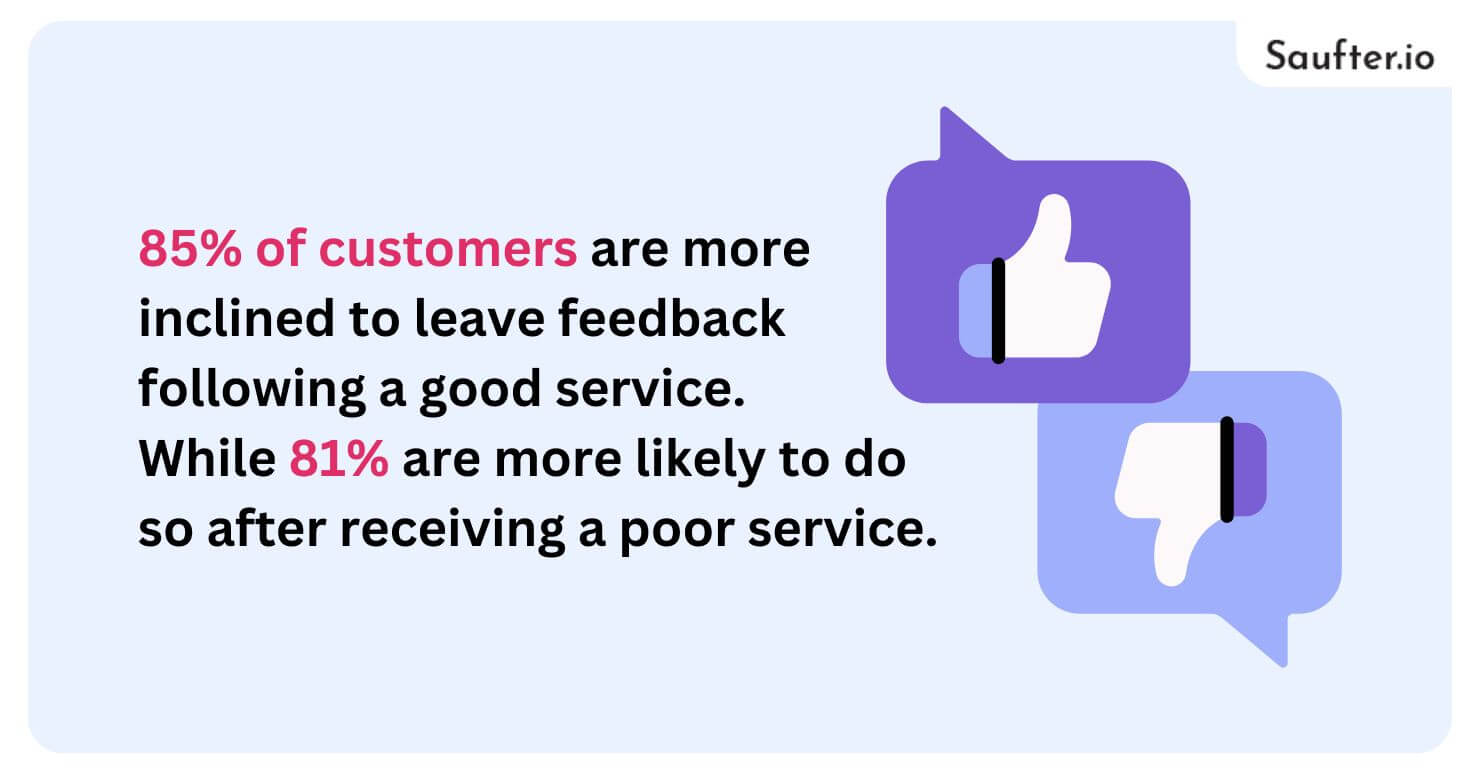
So, here are 8 of the best feedback email samples to make it that much more effective.
1. Decathlon – Product & Service Improvement Focus
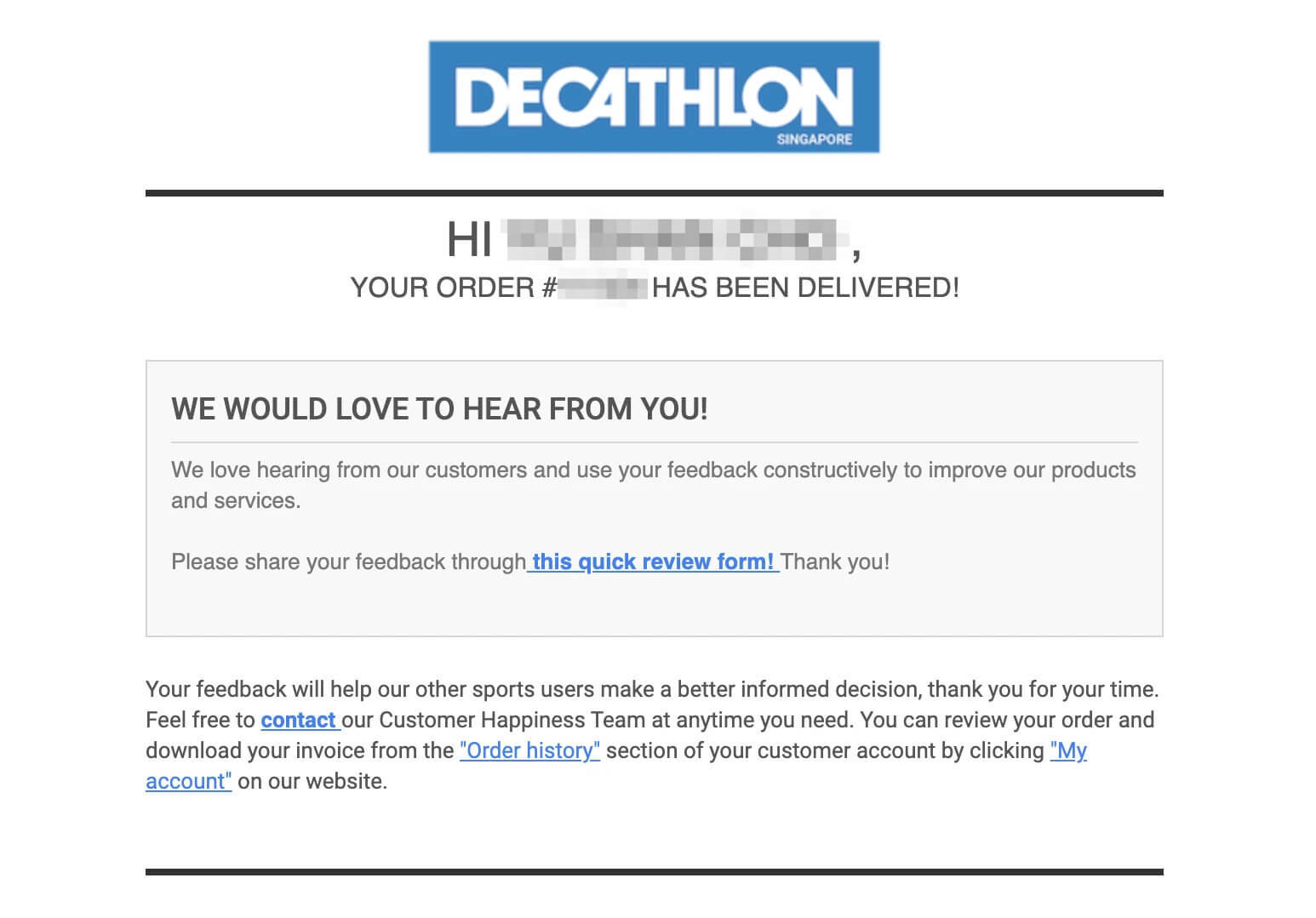
Decathlon’s feedback email is a fantastic model of transparency and intent. They make it explicit that the feedback you give is utilized to make their products better. This direct line lends to a customer’s understanding of why their “content” is important and how it’ll help to improve the experiences in future.
A product-oriented company that goes above and beyond to satisfy customers, connects with their community in a way that promotes feedback between like-minded athletes, developing a better product as a result.
2. Klook – Review for Social Proof
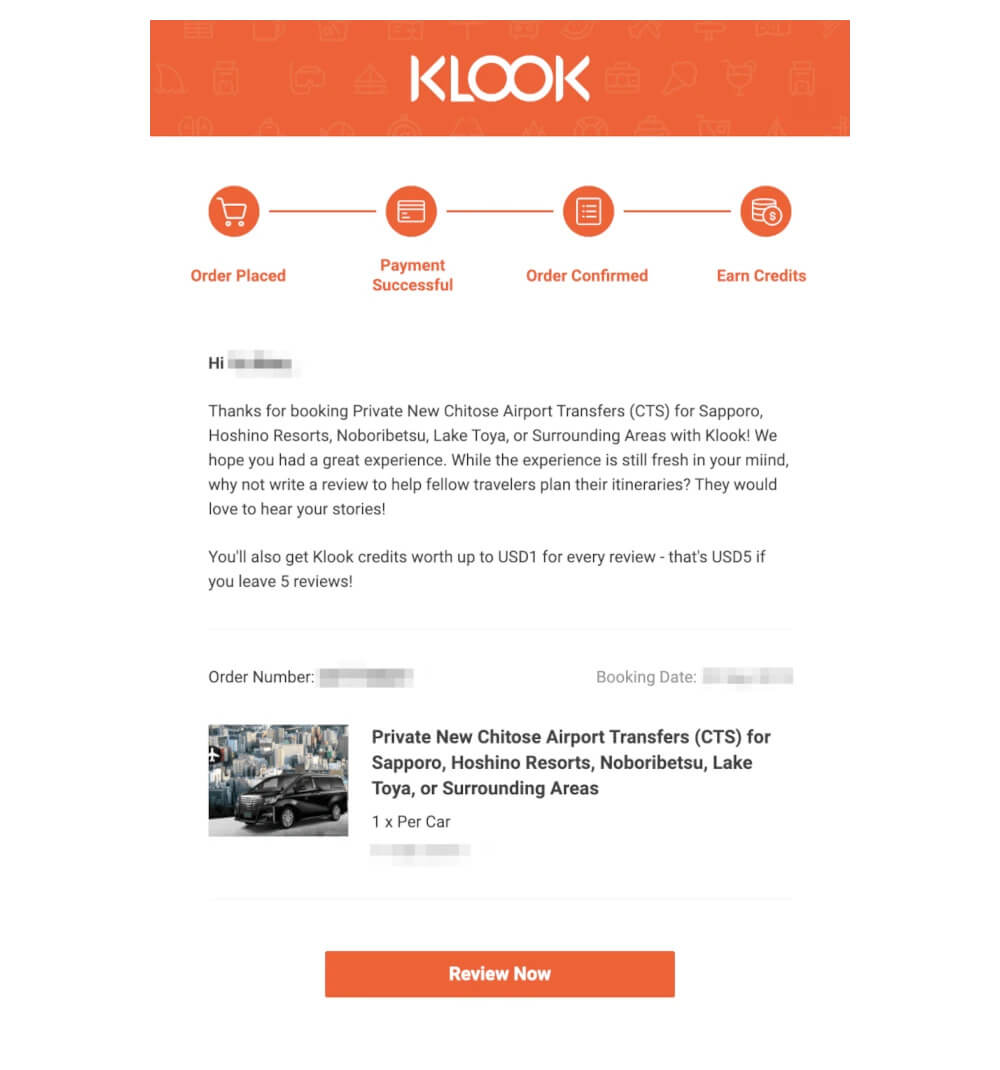
This travel booking platform, Klook, sends messages that are written with the other travelers in mind. Instead of requesting feedback for the company’s internal use, the message makes sure the readers understand that the focus of their review will help provide others with the proper tools to make their own travel decisions.
This social proof aspect motivates your customers to add to this, due to the fact they know their input is able to help direct future users. It’s a shrewd move that marries reputation-building with audience engagement, driving Klook credibility and trust in the travel industry.
3. Asos – Experience-Based Feedback
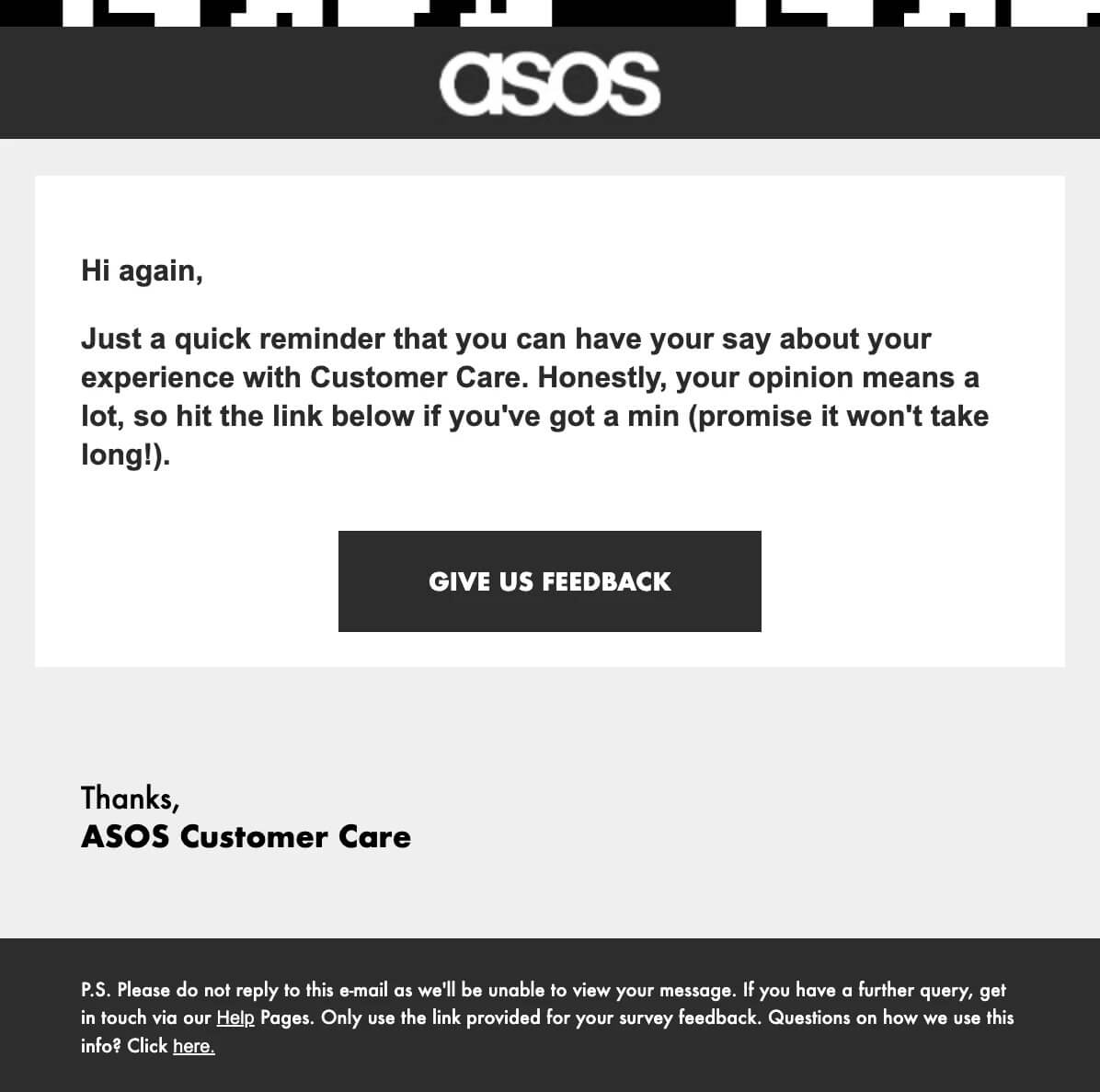
Asos sends out brief, well-written emails to request feedback on the shopping experience in general; covering everything from website to delivery and online support. It’s a straightforward, refined message that makes it easy for you to say what you’re thinking without any of the hassle. It works, because it respects the customer’s time and yet allows to collect relevant insights across multiple touchpoints.
4. Local Bar – Post-Reservation Feedback
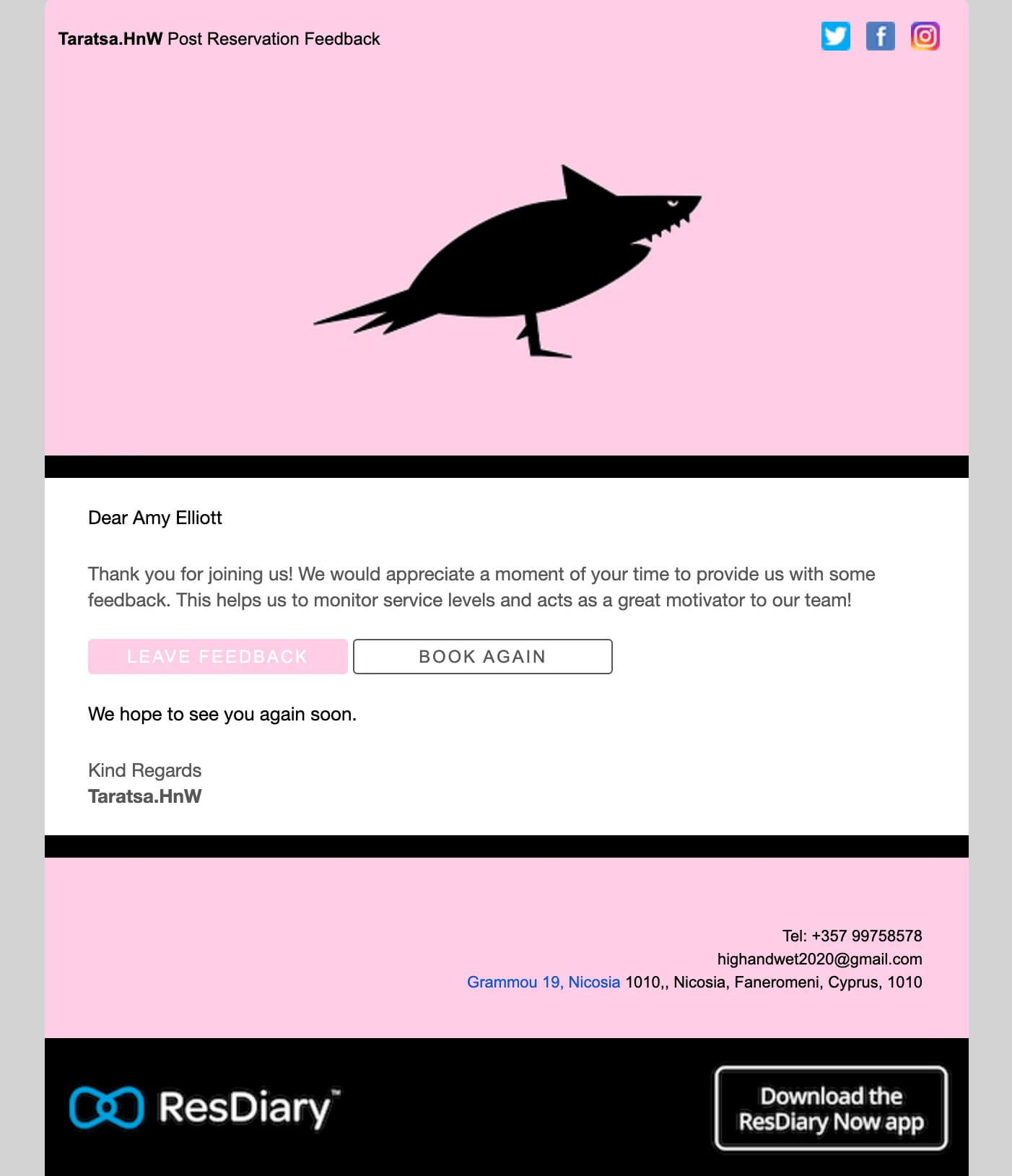
Local businesses, like bars or restaurants, typically want your reservation data to use for follow-up feedback requests. Here’s an example of how a local bar follows up after a reservation, simply asking how the dining experience went.
It personalizes the interaction and allows the business to evolve along with the feedback. Small to medium businesses can preserve quality and offer their valuable customers gratitude by listening to everything they have to say.
5. Forest Adventure – Retention-Focused Feedback
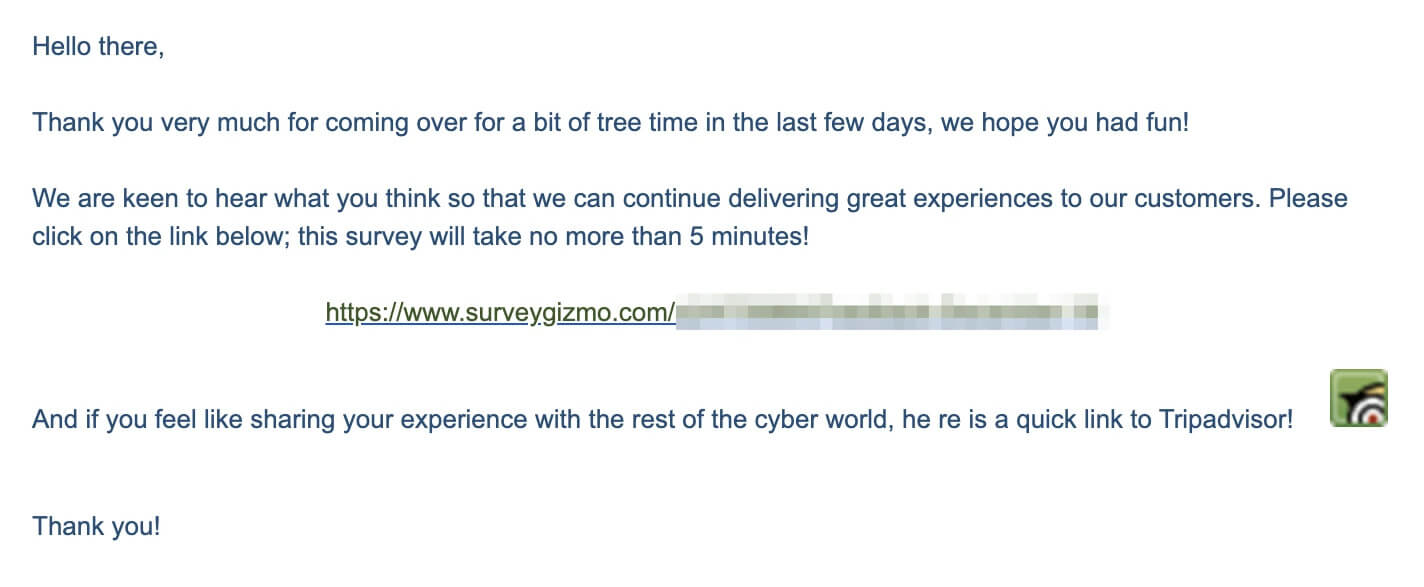
Forest Adventure’s feedback email is dedicated to forging the customer-relationship and keeping the loyal customers. The message seeks to engage former visitors by asking them what they liked and didn’t like.
This message is a good one if you’re an experience-based business, where you’re looking for repeat customers and for word-of-mouth. It shows the company is committed to constant self-improvement, and portrays the brand as customer-focused.
In this way, the Forest Adventure builds relationships and encourages repeat visits by inviting feedback in an upbeat, engaging way.
6. ShopRunner – NPS Survey Email
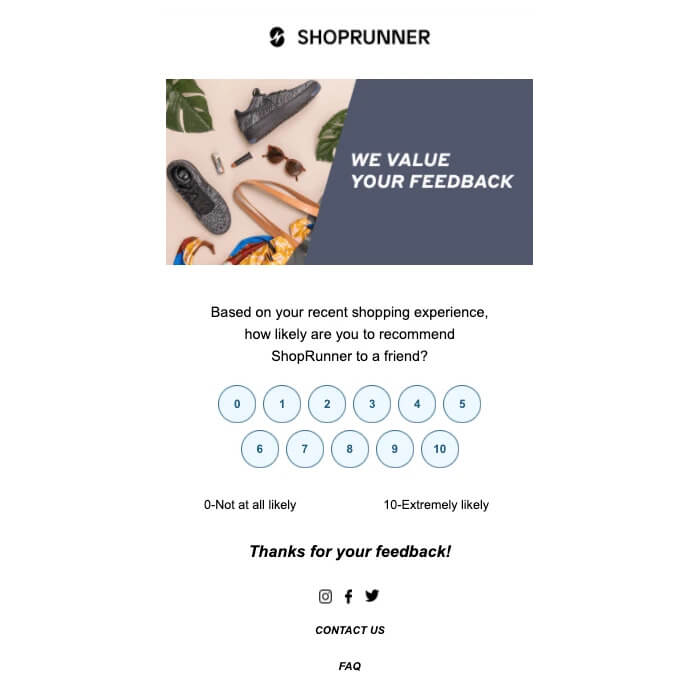
ShopRunner, in their feedback email (that arrives shortly after you make a purchase), uses a Net Promoter Score (NPS) survey. This simple format asks customers how likely they would be to recommend the service to others. The email is tidy, purposeful and easy to answer.
It not just enables ShopRunner in understanding overall satisfaction, but is a resource of actionable information to help with customer retention. They can monitor performance trends and spot locations that might need immediate attention through consistent data collection.
7. IKEA – Incentivized & Reassuring Feedback Request
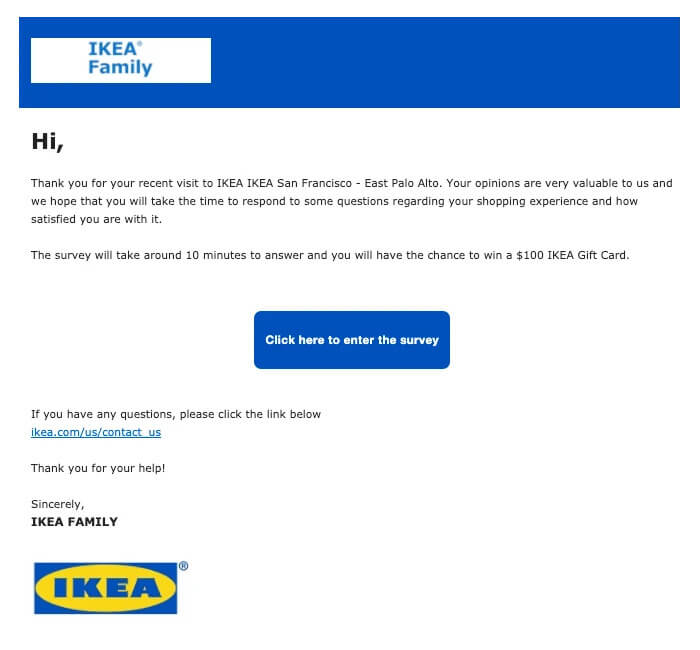
IKEA’s response email has the balance of value and empathy right. And it offers some reward; maybe a small coupon or discount, in an attempt to drive increased responses. Most importantly, it allows customers to know that their input is important and will be used to improve how customers shop.
The tone is friendly and customer-centric, and the recipients feel like they’re listened to and valued. This is part of the way IKEA appeals to excellent customer service and encourages its users to make their feedback even more active.
8. Sundress – Feedback + Discount Offer

Sundress sends a feedback email that is as stylish as it is strategic. Buyers are invited to leave a review after purchase to receive a 15% discount on a future order. The email reads that their feedback helps the company evolve and grow future collections.
This approach maximizes response rates and also promotes re-purchase. It’s a real win-win: The brand gets great information and insights and in return, the customer feels rewarded for their time and feedback.
Saufter: The Best AI-Powered Email Marketing Platform
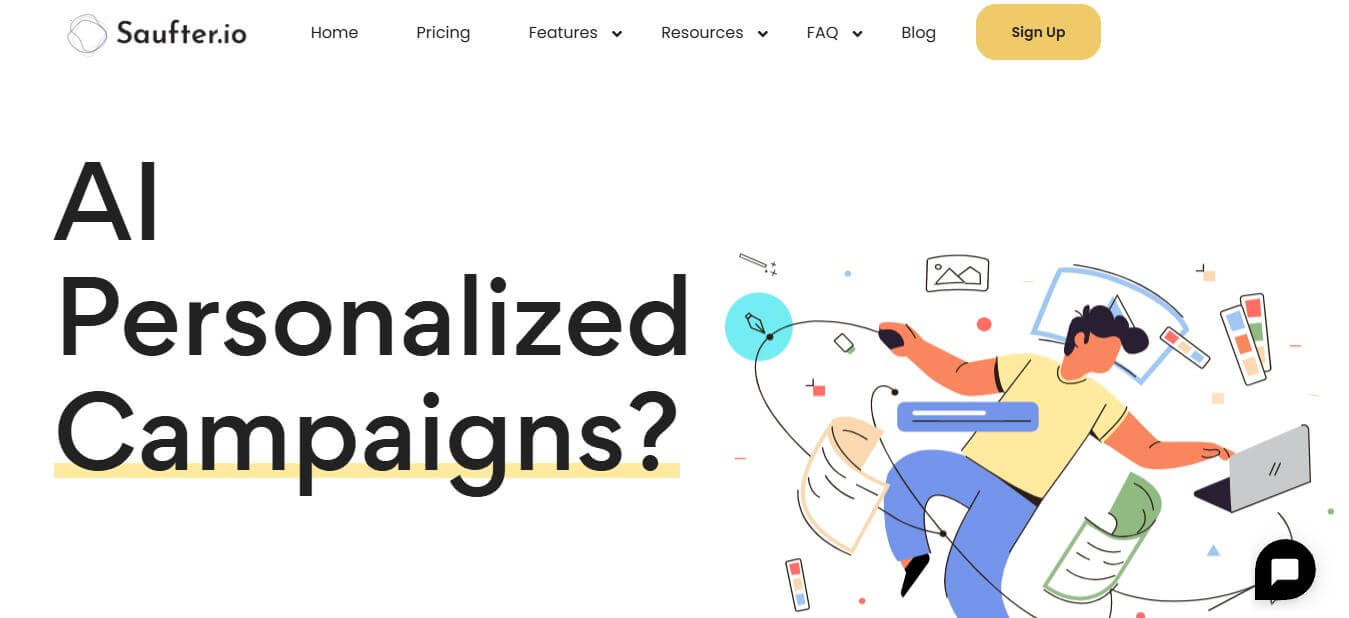
With the help of Saufter, an AI-powered automated email marketing tool, you can take certain actions to augment your feedback collection plan. Saufter’s behavioral intelligence is applied to the analysis of user journeys, competitive email strategy monitoring and automation of personalized campaigns.
No matter if you’re in SaaS or e-commerce, it’s possible to automate engagement through something like trial-based targeting and cart abandonment follow-ups, or post-purchase feedback requests. Guaranteeing that you send the right feedback email to the right customer at the ideal time.
How to Send an Email for Feedback
Knowing how to send an email for feedback is just as important as writing a great message. The timing, delivery method, and personalization all play a role in how effective your email will be. Here’s a step-by-step guide to help you send feedback emails that actually get responses:
1. Choose the Right Timing
Send your feedback email soon after the customer’s interaction—whether it’s a purchase, service request, website visit, or support experience. When the experience is still fresh, customers are more likely to respond thoughtfully.
Best practice: Send within 24–48 hours of the interaction.
2. Segment Your Audience
Don’t send the same feedback email to everyone. Segment your customers based on their activity—such as buyers, subscribers, or support users—and tailor your email content to each group. Personalized emails feel more relevant and increase engagement.
3. Use an Email Marketing Tool
Use email marketing platforms like Mailchimp, Klaviyo, or HubSpot to automate your feedback email campaigns. These tools let you set triggers, customize templates, and track response rates effectively.
Pro tip: Use automation to send emails after specific actions like a completed order or closed support ticket.
4. Personalize the Message
Always use the customer’s name and mention their recent activity. A personal touch makes your email feel authentic, not automated. Referencing what they bought or the service they used shows you value their specific experience.
5. Keep It Mobile-Friendly
Most users check emails on their phones. Make sure your feedback email is optimized for mobile devices—use a clean design, large buttons, and minimal text to keep things simple and actionable.
6. Follow Up (But Don’t Spam)
If the customer doesn’t respond the first time, it’s okay to send one gentle follow-up after a few days. Keep it polite and appreciative, not pushy.
Example: “Just checking in—your feedback means a lot to us, and we’d still love to hear from you.”
By following these steps, you can send feedback emails that are timely, relevant, and more likely to spark a response. Remember, asking for feedback isn’t just about gathering opinions—it’s about starting a conversation and building stronger relationships with your customers.
Conclusion
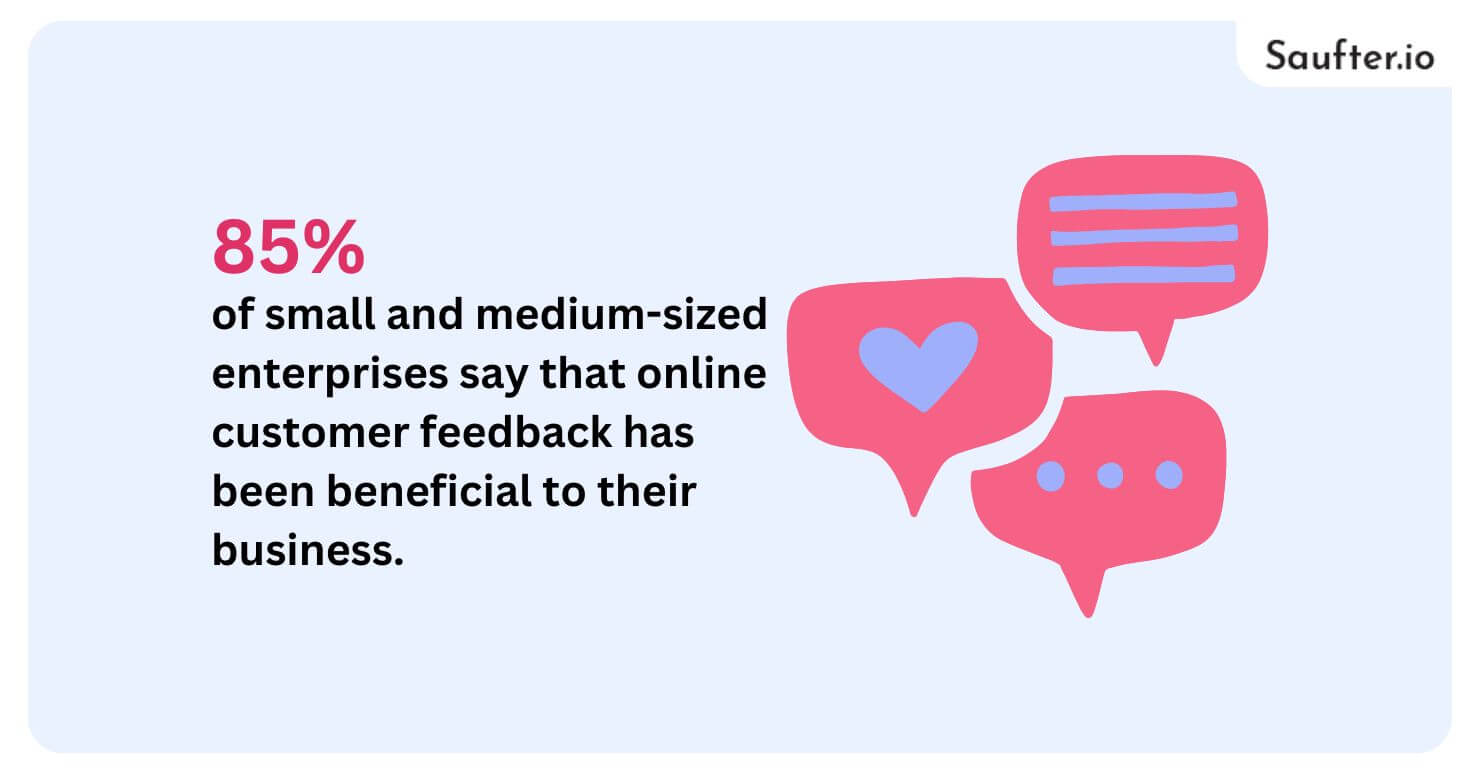
Customer feedback is more than just a way to gather opinions—it’s a vital tool for growth and improvement. In fact, 85% of small and medium-sized enterprises say that online customer feedback has been beneficial to their business. With the right email format and messaging, you can encourage customers to share valuable insights that help shape your brand’s future.
To streamline the process, tools like Saufter make it easy to automate feedback requests, manage responses, and turn insights into action—so you can focus on delivering an exceptional customer experience.
